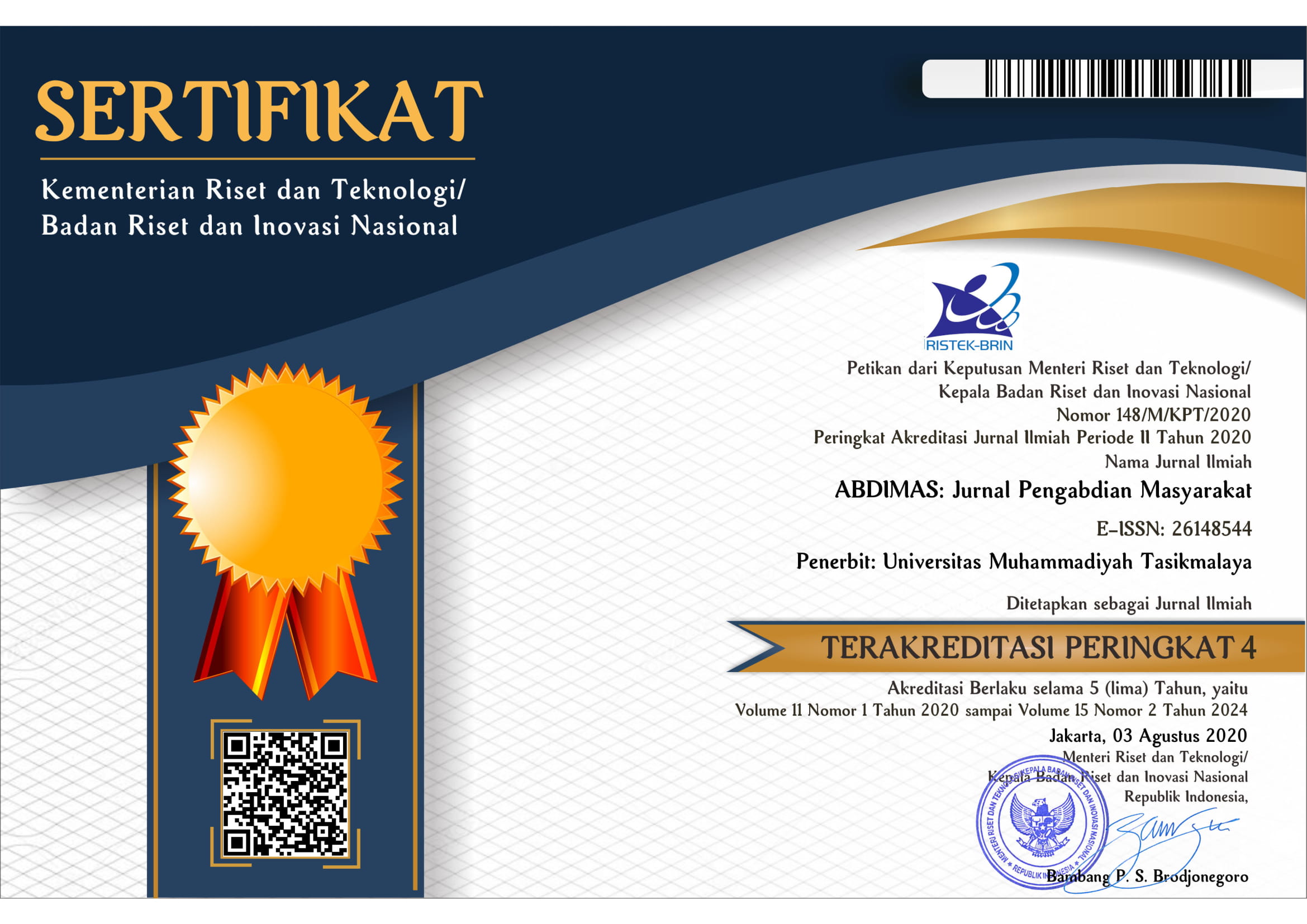Health Education for Mothers With Stunting Toddlers About Supplementary Feeding (PMT) in RW 01 Wetan City Village Sub-District Garut Kota
DOI:
https://doi.org/10.35568/abdimas.v6i4.3953Keywords:
Health Education, Maternal Knowledge, Stunting, ToddlersAbstract
Stunting is not a minor issue; according to World Bank study, losses owing to stunting range between 3 and 11% of GDP. Economic losses due to stunting in Indonesia are projected to be Rp. 300 T-Rp. 1,210 T per year, with a GDP of Rp. 11000 trillion. The money lost is due to the government having to spend additional funds on noncommunicable disease health insurance and addressing stunting instances. Education's goal is to increase knowledge and support stunting prevention behavior in order to lower stunting rates and prevent the appearance of new stunting cases. Learn more about the challenges faced by the residents of RW 01 Babakan Abid Wetan City in their attempts to avoid and overcome stunting. The lecture technique, question and answer, discussion, and demonstration are all used. The health counseling efforts resulted in roughly 33 women with toddlers. When the content was presented, the therapy participants appeared ecstatic. Participants happily participated in the therapy because it was done in an entertaining way. The counselling activity was beneficial since the participants paid close attention to the information offered. This is demonstrated by the amount of participants that want to answer questions during the question and answer session. Participants willingly participated in the counselling because it was done in a nice face-to-face setting. The counseling activity was beneficial since the participants paid close attention to the information offered regarding Supplementary feeding to prevent stunting.
Downloads
References
Adriani, Sisi Oktavia, & Wiwit Febrina. (2021). Efektivitas Pendidikan Kesehatan Terhadap Perilaku Cuci Tangan Pakai Sabun Dalam Upaya Pencegahan Covid-19. Research of Education and Art Link in Nursing Journal , 04(02), 77–88.
Afriani, D., Justian, D., Mentari, W. D., Arisara, G., & Andayani, H. F. A. (2022). Health Promotion Interventions Through Education Nutrition and Practice Cooking Complementary Foods for Mothers of Children in Prevention Stunting. ABDIMAS: Jurnal Pengabdian Masyarakat, 5(2), 2283-2287.
Asriati, A., Adimuntja, N. P., & Ahmad, Z. F. (2022). Socialization of Stunting Prevention with Education to Improve Diet. ABDIMAS: Jurnal Pengabdian Masyarakat, 5(2), 2880-2885.
Atmarita, Zahrani, Y., & Bappenas. (2018). Situasi Balita Pendek (Stunting) di Indonesia (E. S. Sakti, Ed.; 1st ed.). Pusat Data dan Informasi, Kementrian Kesehatan Indonesia.
Aulina, C. N. (2018). Peningkatan Kesehatan Anak Usia Dini dengan Penerapan Perilaku Hidup Bersih dan Sehat (PHBS) di TK Kecamatan Candi Sidoarjo. AKSIOLOGIYA: Jurnal Pengabdian Kepada Masyarakat, 3(1), 50. https://doi.org/https://doi.org/10.30651/aks.v3i1.1480.
Efendi. (2015). Keperawatan Kesehatan Komunitas. In Salemba Medika, Jakarta.
Fitriyani, F. F. (2022). Edukasi Pencegahan Stunting Pada Masyarakat Di Desa Tamiang Kabupaten Tanggerang. Jurnal Abdimas Indonesia, 2(3), 310-315.
Kementerian Kesehatan RI. (2018). Petunjuk Teknis Pendidikan Gizi Dalam Pemberian Makanan Tambahan Lokal Bagi Ibu Hamil dan Balita. Kementrian Kesehatan Republik Indonesia.
Kurnasih, N. (2017). Buku Saku Pemantauan Status Gizi. Kementrian Kesehatan.
Maryunani, A. (2013). Perilaku hidup bersih dan sehat (PHBS).
Proverawati, A., & Rahmawati, E. (2012). PHBS Perilaku Hidup Bersih & Sehat. Yogyakarta: Nuha Medika..
Rahayu, A., Km, S., Ph, M., Yulidasari, F., Putri, A. O., Kes, M., Anggraini, L., Mahasiswa, B., & Masyarakat, K. (2018). Study Guide-Stunting Dan Upaya Pencegahannya.
RI, K. (2020). kemenkes RI. Petunjuk Teknis Pelayanan Puskesmas Pada Masa Pandemi.
Sandjojo, E. P. (2017). Buku Saku Desa dalam Penanganan Stunting . Kementrian Desa, Pembangunan Daerah Tertinggal, dan Transmigrasi.
Sari, C. W. M., Shalahuddin, I., & Pramukti, I. (2021). Adolescent Nutrition Action as a Part of Achieving Healthy Generation in SMPN 37 Babakan Sari Kiaracondong Bandung. ABDIMAS: Jurnal Pengabdian Masyarakat, 4(2), 1107-1114.
Shalahuddin, I., Maulana, I., Eriyani, T., & Pebrianti, S. (2022). Health Education About Anaemia in the RESSPRO Program (Healthy and Productive School Youth) at Himah Cipta Karsa Vocational School Garut. ABDIMAS: Jurnal Pengabdian Masyarakat, 5(1), 1972-1978.
Siregar, N., Syukur, N. A., Suryani, H., Haloho, C. B., & Chifdillah, N. A. (2022). Prevention of Stunting through Cadre Empowerment in the Mangkupalas Health Center Work Area in 2021. ABDIMAS: Jurnal Pengabdian Masyarakat, 5(1), 1745-1749.
Stanhope, M., & Lancaster, J. (2012). Public Health Nursing: Population-Centred Health Care in the Community (Sixth ed.). Maryland Heights, Missouri: Mosby
WHO. (2013). Global nutrition policy review: What does it take to scale up nutrition action
Yulanda, N. A., Ligita, T., Saputri, C. K., Sukmawati, S., & Martadi, K. A. (2022). Reinforcement of the cadres’ role of toddler integrated healthcare center to prevent stunting during the Covid-19 pandemic. ABDIMAS: Jurnal Pengabdian Masyarakat, 5(1), 1693-1696.














